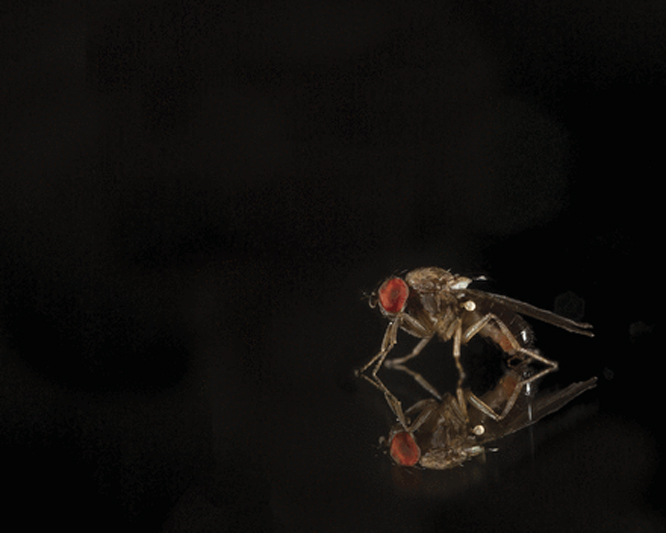Fruit flies suffer from an image problem. Maybe it’s the alliteration in the name, or the association with bananas, but Drosophila have become a go-to target for politicians looking to ridicule wasteful public spending. In February, presidential candidate and US Senator Rand Paul (R-KY) questioned the NIH for spending:
“…a million dollars trying to determine whether male fruit flies like younger female fruit flies. I think we could have polled the audience and saved a million bucks.”
Of course, there’s a lot more to the study, which was really about how the process of aging is regulated. In fact, because many mechanisms of aging are broadly conserved across animals, including Drosophila, research on the signaling networks that regulate this process could eventually have profound impacts on the treatment of age-related diseases like Alzheimer’s.
Fortunately, the spirited mood among the more than 1,500 fruit fly geneticists gathered in Chicago in March for the 56th Annual Drosophila Research Conference suggests the community is prepared to take up the challenge of explaining the value of Drosophila research.
In a passionate keynote address at the Fly Meeting, Allan Spradling argued that Drosophila research is actually among the most productive ways to spend NIH dollars.
#DROS2015 Model organism-centered research has EXPLODED our knowledge base in the last 50 yrs. great message cool data. Mind. Blown.
— Hannah Gordon PhD, MSCI (she/her) (@brieski) March 5, 2015
Spradling attributed most of the recent explosion in genetic knowledge and tools to the post-1950s expansion of NIH funding for research that sought to understand the fundamental principles of biology. And much of that progress was fueled by work on model organisms like Drosophila.
Spradling described many examples from his own research demonstrating the unexpected similarities between the biology of Drosophila and that of mammals, concluding that although conservation of the basic mechanisms of life was one of the most spectacular (and useful) lessons of modern biology, scientists have failed to communicate this message to the public. This failure makes it harder for the public to understand the value of model organism research, which in turn threatens its funding.
One of the great (under appreciated) discoveries of biology: deep conservation across organisms of genes, pathways, & physiology. #dros2015
— Tera Levin (@tera_levin) March 5, 2015
Funding woes have preoccupied most biomedical researchers in recent years, but those working on Drosophila may have it worse than average, argued Michael Wangler, Shinya Yamamoto, and Hugo Bellen in a Perspectives article published in the March issue of GENETICS and distributed as a reprint at the meeting.
According to Wangler et al., NIH funding for Drosophila research has dropped by around 30% over the past five years, compared to a 15% decline for all fields combined. That’s despite the many contributions of the Drosophila model to understanding mammalian biology — like the chromosomal basis of inheritance, genetic linkage, body plan development, the molecular basis of innate immunity, circadian rhythms, and more. Try imagining medical research today without knowledge of Hox genes, Toll-like receptors, or TRP channels, for example, or Notch, Wnt, Hedgehog, and BMP/TGFβ signaling.
The NIH should increase its funding for fruit fly research, the authors of the GENETICS Perspective propose, in part because there is such an unmet need for functional annotation of the human genome. The wealth of Drosophila resources and knowledge make it a powerful tool for accelerating our understanding of gene function, and the authors encourage greater collaboration and communication between fly biologists, human geneticists, and clinicians.
But what about addressing the humble fruit fly’s image problem? Tackling that conundrum was one popular workshop at the meeting, “Communicating Your Drosophila Research to Scientific and Non-scientific Audiences.”
At the workshop, Joyce Fernandes and Raeka Aiyar discussed ways scientists can tailor their messages for different audiences and different goals, Andreas Prokop spoke about a Drosophila outreach project run by the Manchester Fly Facility, followed by Isabel Palacios on DrosAfrica, a project to foster the Drosophila biomedical research community in Africa.
I'm ready to tell everyone I meet about my research after the @GeneticsGSA workshop on communicating science! #DROS2015
— Jamie L. Wood, Ph.D. (@FlyDoc2015) March 6, 2015
Of course, the heart of the meeting was the amazing science shared in talks, at posters, and in conversations over coffees and beers. In many cases, the links to real-world applications were clear. For example, the meeting closed with an engaging talk from Ulrike Heberlein (HHMI/Janelia Research Campus) on using flies to understand the chronic and acute effects of alcohol consumption. Remarkably, fly behavior has become a valuable model for alcoholism.
Heberlein: 80-90% of Drosophila genes with ethanol-related phenotypes show same phenotypes in rodents #DROS2015
— Genetics Society of America (@GeneticsGSA) March 8, 2015
But much of the research at the meeting featured themes so fundamental that their value can’t be reduced to a single disease or application—like the many projects focused on how genomes work, or how to manipulate them, or how they evolve. To the public, this is precisely the kind of research that can seem frivolous or overblown. Invigorated by the science and conversations during the meeting, many attendees left feeling like ambassadors for Drosophila research, determined to tell everyone they meet what such research is truly worth.
Discussed the importance of fly research with the Lyft driver. #DROS2015 #flyoutreach
— Albert Mondragon (@amondragon) March 8, 2015
https://twitter.com/anna_zeidz/status/573875910459396096
Check out the program book and #DROS2015 on Twitter for meeting highlights. Those eager to share their enthusiasm for fly research can find many useful communication resources at the Manchester Fly Facility’s public outreach website. The Drosophila Communications Committee has also prepared some slides for researchers on “What you can do.” And GSA is working to develop a resource on the value of research with model organisms. Stay tuned!
CITATION
Fruit Flies in Biomedical Research
Michael F. Wangler, Shinya Yamamoto, and Hugo J. Bellen
Genetics March 2015 199:639-653; doi:10.1534/genetics.114.171785
http://www.genetics.org/content/199/3/639































